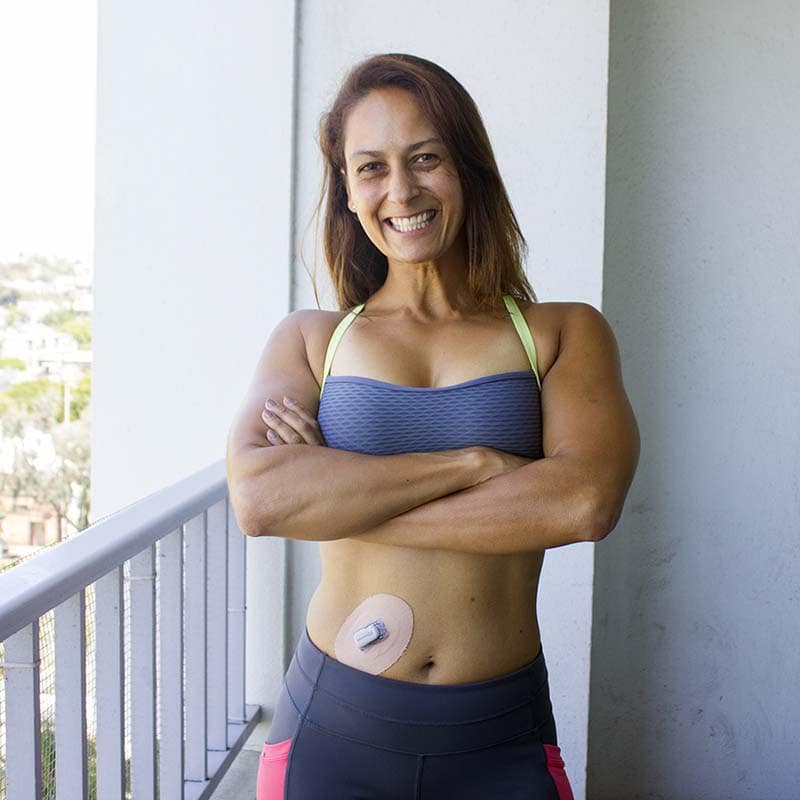This post may contain affiliate links. Please read our disclosure.
Warm days, outdoor workouts, and frequent dips in the pool are amazing. Unfortunately, hot summer days and workouts can also mean that your CGM sensor tape starts to peel, which could mean a shorter lifespan for your sensor.
Obviously, nobody wants that, so I’ve tested different brands of Dexcom patches to see if they were comfortable to wear and could prolong my sensor lifetime.

I tested these patches with a Dexcom sensor but most of the brands I tried offer patches for Dexcom, Freestyle Libre, Eversense, and Medtronic, as well as pump and blood glucose meter adhesives.
Since I’ve only tested a handful of the patches available, feel free to add your favorite CGM tape in the comment below.
I should also mention that many people add an adhesive (like skin glue) to their skin under the tape for the sensor to stick longer. I’ve never had huge success with the additional adhesive and I didn’t wear it with any of the CGM patches I used in this test.
What’s important in a CGM patch?
When it comes to picking sensor patches, I value:
- How well and how long it sticks to the skin
- If it’s waterproof and lets my skin breath
- Design and color choices
- Reasonable pricing
In general, I don’t wear a sensor longer than 7-10 days (which is also what the Dexcom G5 and G6 are approved for). The primary reason I only wear the sensor for 7-10 days is that I have fairly sensitive skin and wearing it longer can be an itchy and painful experience.
I know that some of you wear the sensors for much longer than I do, but, unfortunately, I can’t tell you how these patches perform if you wear them for more than 10 days.
GrifGrips
This was the first sensor tape I came across when I started wearing my Dexcom and it’s by far the most durable of all the patches I’ve tried. It actually sticks so well to the skin that it can be hard to get off.
I’ve had to use glue remover (Uni-Solve works well and is also great for removing glue residue) to make removing the patch less uncomfortable. Needless to say, the GrifGrips will easily stay on for 7-10 days.
Most of the grips are made of a material much like sports tape, so it doesn’t feel restrictive or stiff, and the skin can breathe because you won’t sweat under the patch but through it.
You can choose between 5 different adhesive options, so this is a great option if you have sensitive skin or can’t tolerate pigments or dyes.
If you want your grip to be colorful, GrifGrips come in a variety of colors and shapes. I haven’t tried their multicolored designs, which are made of a different material, so I can’t say if they stick as well.
Prices vary by design and the volume of patches you purchase. You can get a 10-pack of basic colored oval grips for $10 plus shipping.
You can find all the designs on the GrifGrip website as well as a selection on Amazon. The oval sports tape that I most often pick is $20 for 20 grips on Amazon ($1/patch).

Skin Grip
The Skin Grip CGM patches are very similar to GrifGrips. They are also made of a soft fabric-like material. However, it’s a much smaller company and they only offer oval and round patches in a small variety of different colors, one being “tan”. Unfortunately, their definition of tan is not the same as my skin color.
That aside, what really sets Skin Grips apart from GrifGrips is the peel-off paper.
The paper is precut into four pieces, so instead of having to peel it all off at once and having to manage a very sticky grip (I’ve messed up a few grips because they got glued to themselves before I got them on my skin), you can simply loosen up the edges, place the grip over the sensor, and then remove the paper. Simple but brilliant.
You can see how I put on the Skin Grip in this video:
I’ve found that the material feels slightly lighter than the GrifGrips but sticks just as well. It also doesn’t irritate my skin.
Prices are very reasonable, with a 20-pack of patches being $24.99 ($1.25/patch) on Amazon.

ExpressionMed
These CGM adhesives are fun and colorful, and you can get a broad range of cute designs. They’re predominantly oval patches but you can also get a few other fun shapes, including mini tapes that are smaller than most of the patches I’ve seen.
I tried their owl-shaped and heart-shaped patches (not available anymore), which some might argue cater more to the younger audience (but who cares, I’m young at heart!).
This is definitely for people who aren’t shy about showing off their diabetes gear and I really enjoyed wearing them.
The major downside to these grips is that they are printed on material that feels more like paper than sports tape. They felt stiffer than both GrifGrips and Skin Grips, and they didn’t last me more than a few days.
My take is that these CGM patches are a way to beautify the sensors rather than making sure they stick longer.
They are quite a bit more expensive than the patches above, with an average patch price of $3/patch when you buy a 5-pack and $4 for a single patch. You can find them on Amazon or the ExpressionMed website.

Pump Peelz
Like the ExpressionMed CGM patches, Pump Peelz brings the fun when it comes to designs. They have a larger selection of print designs than any of the other brands but only come in a single oval shape.
Much like ExpressionMed, the prints are on material that feels more like paper than fabric, so they also tend to wrinkle a little and don’t last me as long as GrifGrip and Skin Grips.
However, if you’re looking for a way to jazz up your CGM for any occasion, you can find it here. They’ll even print your own design if that’s what you prefer. I wore their American flag when I became a US citizen and thought that was very appropriate.
The designs seem slightly more mature than ExpressionMed. I had a lot of fun wearing them and would definitely buy them again. But mainly to wear in the wintertime because they don’t handle heat (and sweat) as well as some of the other patches.
You can buy a single patch for $3.49 or a pack of 5 patches for $12 ($2.4/patch), and you can pick as many different designs as you like on their website.

Transparent adhesives
The transparent adhesives like Tegaderm and Flexifix are not really patches but rather medical adhesives/tape.
I can’t help getting the feeling that I’m putting office tape on my body whenever I’ve used them. Since they are made from a plastic-like material, my skin cannot breathe, and the adhesives usually don’t last long since sweat will pool up under the adhesive rather than go through it.
I find that my skin becomes red and irritated very quickly, and the only upside I see to this solution is that it’s relatively cheap and see-through.
Flexifix was the last brand I tried, and I received a large roll of tape, which can easily be cut into whatever shape you want. That is, of course, an advantage if you don’t like the larger CGM patches available (I have written about how to cut the tape here).
If you want to try it out, you can find it on Amazon.
Which Dexcom patch would I recommend?
If the goal is to make the Dexcom sensor stay on longer, and you don’t care about colors, shapes, and designs, I’d recommend the Skin Grips. They slightly outperform GrifGrips at the same price, they’re easy to apply, and they stick.
Although super fun and cute, the ExpressionMed patches and the Pump Peelz are more a way of beautifying your CGM sensor than a way to truly secure the sensor and prolong its lifetime.
That doesn’t mean I won’t wear them (I actually really like how fun they are), but, for me, they’ll just be more of a winter wearable.
UPDATE: Other great Dexcom patches that I’ve tried after writing this article:
Not Just A Patch – Funky colors and a funky shape for $21.99 for 20 patches
Dexcom’s Free Overlay tape – I didn’t like this tape but I am adding it as it’s free. Just request a tape through the Dexcom app or contact Dexcom through their website.





Lisa
I also have sensitive skin & end up with a red, raised rash at the end of 10 days. I can feel the itch discomfort coming on about day 3 or 4. However, I’ve had better luck with covering the patch & sensor with a waterproof “island” bandaid that I change every 24 to 48 hours. I still get a rash but it’s not nearly as bad if I can keep the area dry. Also, I think part of the problem is with sweating during a workout that gets trapped under the adhesives.
Frank
Hello. I am late to the game here and new to the diabetes world. I wear the Freestyle Libre 2. I do hot yoga 4-5 times a week and am also a martial artist. I had a sensor ripped off doing martial arts and looked into something to help secure the sensor. I tried Not Just A Patch along with Skin Tac Wipes and it did well. It stayed secure for the entire 14 days and was comfortable. It did slighly fray around the edges but not too bad. All-in-all I was very happy with it. I did get a sample of Skin Grip patchs and are trying them right now to compare.
JERI Wofford
Not Just A Patch sells G6 patches on Amazon in lots of solid colors. They give you the choice of leaving on a small nonstick part of the patch to go over your sensor or you can peel it all off so that the patch sticks on everything. I got the hot pink and so far they work great for the entire 10 days with no issues.
Cost is about 20.00 for 20 patches.
Richard Rothman
Hi Christel,
I use the free Over Patches from Dexcom, but I apply “Skin-Tac” first, you get 50 wipes p/box. I pay $18.oo at a local Delta Pharm. You don’t need the whole amount on the wipe. Just reseal the pack, it’s real sticky and will seal to itself once you fold it over, and you can get another use out of it.(So you can get more than 50 wipes p/box, for the same money) I have a very acidic skin and most tapes won’t stick to me. As a matter of speaking my body will literally eat through watchbands if they’re not stainless steel or another precious metal band. So if anybody has an adhesion problem(such as I do) they should try the “Skin-Tac”. It’s very flexible and non irritating on the skin.
I hope this helps someone.
Rob
Is there a way to buy the Skin Grips for the G5 ($14) and make them work for the G6 ($24)?
Christel Oerum
I haven’t seen the $14 pricing… They should be the same price for G5 and G6
Chris
Christel,
I started using the G6 in January, 2020. I went thru three boxes, about 3 months worth, and was ecstatic. No problems or concerns. When I started the next sensor, from a new box, and a net lot, I was very allergic to the adhesive. After being told by one rep at Dexcom that nothing had changed with the sensor, I finally talked with a patient care nurse who told me that the formula for the adhesive was in fact changed. She said that they had so many complaints that the sensor would not stay on for10 days. The adhesive formula was changed at the beginning of this year.
For those of us that are allergic, do you have any suggestions, or workarounds, to alleviate the symptoms? I appreciate any advice!
Victoria
I also have terribly sensitive skin. What I’ve found to help is to clean the skin thoroughly with several alcohol wipes, then spray some fluticasone spray on the skin (not too much since it causes the sensor to not adhere well in hot, humid conditions). Allow the spray to dry completely, then place a piece of tegaderm over the area and top with the sensor. After a few days I’ll place a cover over that to extend its life. I use a Dexcom G6. I can get twenty days out of a site this way, though the area definitely looks rough near the end. It’s not perfect, because I still get itchy skin (I start itching by the 2nd to 3rd day no matter what I’ve tried, but it’s more bearable with this set up.)
JOAN
I really like Lexcam patches. They are thin like the 3M Nexcare bandages and they stick REALLY well.
Vincent Caira
Where is the best place to put sensor in the body. the arm or stomach.
if placed on the arm will there be any concerns?
Christel Oerum
The Dexcom CGM is only approved for abdominal wear, the Libre only for the arms and the Medtronic CGM is approved for both arms and abdomen. That being said, that only means that they have been clinically tested for wear in those places. People generally wear them where they find it most comfortable
SMD
The key factor is that the Dexcom sensor must be inserted in adipose (fatty) tissue. If it penetrates muscle tissue it will not function properly, largely due to blood rather than the interstitial fluid that Dexcom sensors measure.
Trent Schermerhorn
Hello, I’m approaching 50yrs T1D and have been using the G6 for the past 18 months. I’ve tried many placement locations. Abdomin is my least favorite location. Too much scar tissue from too many daily injections (prior to pump therapy) for too many years. I prefer back of biceps, side triceps and side of thighs.
FYI Dexcom makes great free G6 overpatches MT22994, but you have to request them (pack of 10). Foolish I know, not sure why they don’t come automatically with box of 3 sensors.
Try them, I’ve rarely had one come loose even with lots of saltwater swimming!
Robert Shrigley
I have recently upgraded to the G6 and am wondering how it is affected by hot tub immersion and Tylenol interaction. I was told to use neither while on the G5.
Christel Oerum
I don’t believe there is an issue with hot tubs. The only medical warning I could find on their website was this:
In previous generations of Dexcom CGM systems (G4/G5), acetaminophen could affect your sensor readings, making them look higher than they really were. However, with the G6, you can take a standard or maximum acetaminophen dose of 1 gram (1,000mg) every 6 hours and still use the G6 readings to make treatment decisions. Taking higher than the maximum dose of acetaminophen (e.g. > 1 gram every 6 hours in adults) may affect the G6 readings and make them look higher than they really are.
Ric
Thanks for the info. How do you address cortisone shots in knee joints? Your readings go out of wack after injections.
Christel Oerum
I know cortisone shots can increase blood sugars. If you manage with insulin or other diabetes medication I’d suggest you discuss how to increase your doses with your doctor. If you don’t use any diabetes medication you probably have to accept slightly higher blood sugars for a while, but you could all more cardiovascular activity such as arm circles, hand-bike (if you have access to a gym) or swimming
Sally Ann Ely
I learned what cortisone shots can do to blood sugar when I had one in my hip and one in my knee in November. When they elevated my blood sugar within hours and it wouldn’t go below 200 even with increasing my mealtime insulin, I checked with my endo who advised me to increase my basal. It was at least a week before I went back to my normal dose and I still needed extra at mealtime. An appt. with an orthopedist led to a series of Euflexxa injections with no effect on my blood sugar.
Judy Godliman
I recently had detached retina surgery and they gave me tylenol #3 and told me not to take ibuprofen but acetaminophen for pain and headaches. About 2 weeks in I felt faint, shaky and was really sweating. My Dexcom showed 220 and I have become so reliant on the accuracy of the Dexcom I believed the reading. Not until another nurse who I work with said your symptoms look like you’re low…test your sugar and sure enough I was 55. I forgot about the acetaminophen issue. So I have been staying away from acetaminophen since. Still love my Dexcom G6!!
Sheila McConnell
I have receivd0verpack from Dexcom . Will these packs protect the sensor when I’m in the Hot tub or in the pool. During Physical Therapy
Christel Oerum
The overlay tape will help keep the sensor in place so it doesn’t fall off as easily. If it starts to peel, you can add a new tape or glue it down again